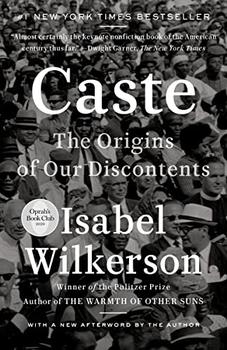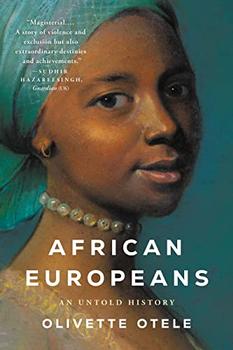Summary | Excerpt | Reading Guide | Reviews | Beyond the book | Read-Alikes | Genres & Themes | Author Bio

The Origins of Our Discontents
by Isabel WilkersonIn 2020, the word "racist" remains taboo. Conceptually, racism is so culturally unacceptable, so ugly and indefensible, that even the alt-right take pains to acquit themselves of accusations of it. However, despite the fact that almost nobody will admit to being racist nowadays, inequality and racial prejudice continue to exist. Resistance to the word does not address the problems it is meant to describe; it merely makes them more difficult to articulate.
In Caste: The Origins of Our Discontents, Pulitzer Prize-winning journalist Isabel Wilkerson offers an alternative language for these problems — that of caste. Through this conceptual shift, she is able to advance the conversation about the structural power imbalances that permeate American society and reveal the deeper machinations of racial hierarchy. "The modern-day version of easily deniable racism may be able to cloak the invisible structure that created and maintains…inequality," she writes. "But caste does not allow us to ignore structure. Caste is structure." According to Wilkerson, caste predates the notion of race. It is "insidious and therefore powerful because it is not hatred, it is not necessarily personal. It is the worn grooves of comforting routines and unthinking expectations, patterns of a social order that have been in place for so long that it looks like the natural order of things." Caste is, she claims, "the basis of every other ism."
A caste system, as defined in Wilkerson's remarkably in-depth and powerful study, is "an artificial construction, a fixed and embedded ranking of human value that sets the presumed supremacy of one group against the presumed inferiority of other groups." Wilkerson identifies eight "pillars" by which these systems are kept intact, a rigid set of beliefs designed to justify the natural superiority of the dominant caste as well as to distance and dehumanize the subjugated caste. These include divine law, notions of purity, endogamy and occupational hierarchy. She compares the race-based American caste system to two other prominent caste societies: those of India and Nazi Germany. This serves to show that while caste systems may come in different forms, using different arbitrary features to designate power, their structures are much the same. "Each version," she writes, "relied on stigmatizing those deemed inferior to justify the dehumanization necessary to keep the lowest-ranked people at the bottom and to rationalize the protocols of enforcement."
Wilkerson writes clearly and with a gravity that matches her subject matter. Her masterful and at times poetic use of allegory adds color and emotional resonance to her academic analysis, such as when she relates the story of a strange sickness that swept through Siberia in 2016, which eventually was discovered to have been caused by anthrax buried under permafrost. It had been there since World War II, but now, because a radical heatwave had hit the area, it had been released from the snow. The anthrax, she says, is "like the reactivation of the human pathogens of hatred and tribalism in this evolving century...It lay in wait, sleeping, until extreme circumstances brought it to the surface and back to life."
The book is painstakingly researched, with thousands of testimonials and case studies, both historical and contemporary. Each anecdote conveys an element of the barbarity and perversity of the caste system. Wilkerson relays these incidents with calm authority, equal parts blunt and tender, laying bare the exceptional cruelty that the delusion of caste can engender. The horror of descriptions of the Jim Crow South, in which the bodies of African Americans were dismembered after lynchings and distributed as souvenirs, is juxtaposed with more banal forms of subjugation in Wilkerson's own experience, such as the subtle prejudices she encounters while flying first class. Using the caste model, she is able to show the pervasive and harmful impact of this structure on how we all live, dominant and subdominant castes alike. The caste system rumbles beneath the surface, erupting occasionally when pressure is applied.
Although Wilkerson's book is steeped in suffering, her concluding message is one of hope. In the last chapters, she offers a glimmer of light, a future that could be brighter than the historical cruelties she portrays. To get there would require a kind of "radical empathy," the kind that is able to recognize "the pain of another as they perceive it." By educating ourselves and committing to a vigilant awareness of history, we can, she suggests, begin to deconstruct hierarchies. This remedial work, of which her book is a part, will lead us to a place of harmony. "In a world without caste," she writes, "instead of a false swagger over our own tribe or family or ascribed community, we would look upon all of humanity with wonderment."
![]() This review was originally published in The BookBrowse Review in October 2020, and has been updated for the
March 2023 edition.
Click here to go to this issue.
This review was originally published in The BookBrowse Review in October 2020, and has been updated for the
March 2023 edition.
Click here to go to this issue.

If you liked Caste, try these:

by Olivette Otele
Published 2023
A dazzling history of Africans in Europe, revealing their unacknowledged role in shaping the continent.

by Ibram X. Kendi
Published 2023
From the National Book Award–winning author of Stamped from the Beginning comes a bracingly original approach to understanding and uprooting racism and inequality in our society - and in ourselves.
Your guide toexceptional books
BookBrowse seeks out and recommends the best in contemporary fiction and nonfiction—books that not only engage and entertain but also deepen our understanding of ourselves and the world around us.